Scottish Crime and Justice Survey 2016/17: main findings
This report details the main findings from the Scottish Crime and Justice Survey conducted 2016-2017.
This document is part of a collection
1. Introduction and background to the SCJS
What is the SCJS and what purpose does it serve?
The Scottish Crime and Justice Survey ( SCJS) is a large-scale social survey which asks people about their experiences and perceptions of crime. The 2016/17 survey is based on around 5,600 face-to-face interviews with adults (aged 16 or over) living in private households in Scotland. Crime and victimisation surveys have been carried out in Scotland since the early 1980s; however, this report presents the results for the sixth SCJS, with interviews conducted between April 2016 and May 2017.
The main aims of the SCJS are to:
- Enable the Scottish population to tell us about their experiences of, and attitudes to, a range of issues related to crime, policing and the justice system; including crime not reported to the police;
- Provide a valid and reliable measure of adults' experience of crime, including services provided to victims of crime;
- Examine trends, over time, in the number and nature of crimes in Scotland, providing a complementary measure of crime to police recorded crime statistics;
- Examine the varying risk and characteristics of crime for different groups of adults in the population.
The findings from the SCJS are used by policy makers across the public sector in Scotland to help understand the nature of crime in Scotland, target resources and monitor the impact of initiatives to target crime. The results of this survey provide evidence to inform national outcomes and justice outcomes.
Who takes part in the SCJS and what topics does it cover?
The SCJS does not aim to provide an absolute estimate for all crime and has some notable exclusions.
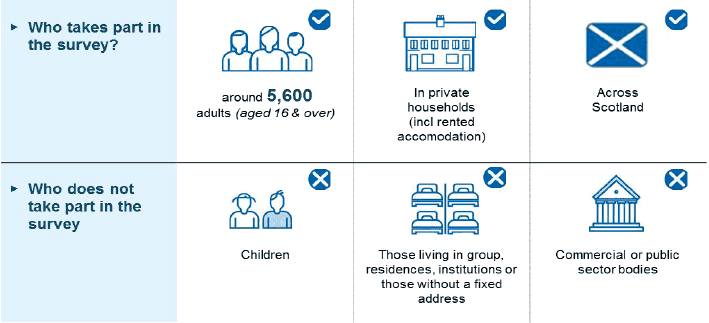
The SCJS is a survey of adults living in private residential households (including private and social rented housing) and, therefore, does not provide information on crimes against adults living in other circumstances (for example tourists and those living in institutions or communal residences, such as prisons or hospitals, military bases and student accommodation). The survey also excludes persons under the age of 16 and crimes against businesses. Further details on the sampling approach is outlined in the accompanying Technical Report.
The SCJS is primarily a victimisation survey and, as such, captures information on adults' experiences of violent crime and property crime, including those not reported to the police. However, it does not capture data on all crimes, for example, crimes without a direct victim ( e.g. speeding and drug possession), and some high harm but relatively lower-volume offences, such as homicide and sexual offences, which are not included in the main estimates. Whilst details of threats are collected in the survey, they are not currently included in the crime statistics as it is difficult to establish whether or not an offence has been committed. Experiences of sexual offences are collected in the self-completion section and reported separately.
Throughout the report, the term 'crime' is used to refer to any in-scope incident recorded by the survey, occurring during the interview reference period and in Scotland, in which the respondent or their household as a whole was the victim.
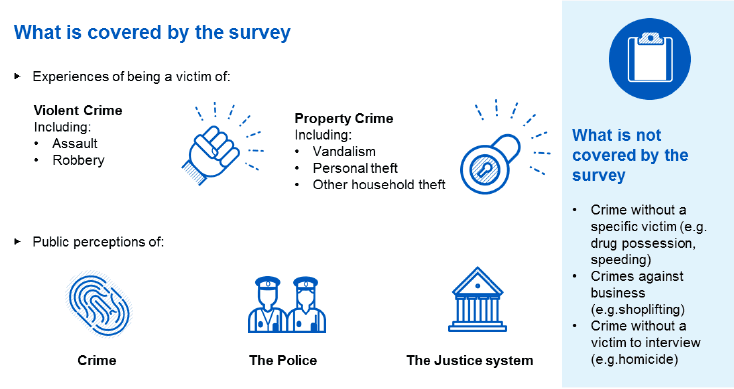
Respondents also self-complete a questionnaire that covers drug use, partner abuse, sexual victimisation & stalking
How far back does the SCJS time-series data go?
While crime and victimisation surveys have been carried out in Scotland since the early 1980s, the geographical coverage, sample size, method and fieldwork and reference periods have varied.
A history of crime and victimisation surveys in Scotland
1982, 1988: British Crime Survey ( BCS) included coverage of central and southern Scotland only (c. 5,000 interviews).
1993: First independent Scottish Crime Survey ( SCS) launched, based on BCS and covering the whole of Scotland (c. 5,000 interviews).
1996, 2000, 2003: Further sweeps of the SCS (c. 5,000 interviews).
2004, 2006: Scottish Crime and Victimisation Survey ( SCVS) (c. 27,000 interviews in 2004, c. 5,000 interviews in 2006).
2008/09, 2009/10, 2010/11: Scottish Crime and Justice Survey ( SCJS) conducted annually (c. 16,000 interviews 2008/09 and 2009/10, c. 13,000 interviews in 2010/11).
2012/13, 2014/15: Scottish Crime and Justice Survey ( SCJS) conducted biennially (c. 12,000 interviews in 2012/13, 11,500 interviews in 2014/15).
2016/17 onwards: Scottish Crime and Justice Survey ( SCJS) conducted annually (c. 5,570 interviews in 2016/17, from target of 6,000)
Time series comparisons in this report are generally made to 2008/09 and to 2014/15. Prior to 2008, victimisation surveys were intermittent and had smaller sample sizes (around 5,000 interviews). Surveys were administered using paper questionnaires by interviewers and early surveys did not cover the Highlands and Islands of Scotland. In 2003, the McCaig review (2003) [1] of the design, content and management of the survey found the survey was unable to produce trends, had high margins of error around results (especially around less common crimes) and was unable to report findings below the national level. In 2008, the sample size increased, and surveying moved to fieldwork throughout the financial year and used a rolling reference period for the victimisation module.
How is the survey delivered?
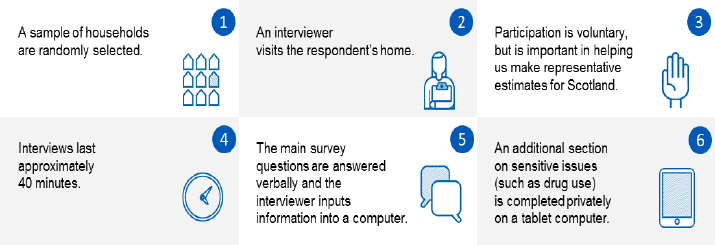
The design of the 2016/17 SCJS was broadly similar to the design of the SCJS from 2008/09 to 2014/15:
- Survey frequency: From 2012/13 the survey was conducted biennially. Therefore, no survey ran in 2015/16, with the last SCJS being in 2014/15. In 2016/17, the SCJS reverted to being conducted on an annual basis.
- Sample: the sample is designed to be representative of all private residential households across Scotland (with the exception of some of the smaller islands). A systematic random selection of private residential addresses across Scotland was produced from the Royal Mail Postcode Address File ( PAF) and allocated in batches to interviewers. Interviewers called at each address and then selected one adult (aged 16 or over) at random from the household members for interview.
- Questionnaire: the questionnaire consists of a modular design completed by the interviewer using Computer-Assisted Personal Interviewing ( CAPI) and a self-completion section covering sensitive crimes using Computer-Assisted Self Interviewing ( CASI). Annex C gives an overview of the questionnaire structure and general topics, and the most recent questionnaire is available on the SCJS website.
- Fieldwork: interviews were conducted on a rolling basis between April 2016 and May 2017, with roughly an equal number of interviews conducted across most months. Challenges in fieldwork delivery were experienced and as a result, the fieldwork period was extended to increase the achieved sample size.
- Interviews: 5,567 face-to-face interviews were conducted in respondents' homes by professional interviewers from an original target of 6,000. The achieved response rate was 63.2%, against a target of 68%. This shortfall was similar to the achieved response rate in 2014/15, 63.8%, (but lower than the 67.7% achieved in 2012/13). Additional information about the impact of the fieldwork challenges is provided in the Technical Report.
- Interview Length: Interviews lasted on average around 40 minutes, though there was variation in interview length, depending on the respondent's reported experience.
- Time period covered: respondents were asked about incidents experienced in the 12 months prior to the month of interview (the reference period). The time period covered by the data included in this report extends over 25 months (April 2015 to May 2017) so is not directly comparable with any calendar year.
- Weighting: the results obtained were weighted to correct for the unequal probability of selection for interview caused by the sample design and for differences in the level of response among groups of individuals.
Further information about the design and methodology is contained in the accompanying Technical Report.
What results does this report include and where can I find them?
The report is split into seven main chapters, presenting data for the majority of topics covered by the survey questionnaire and is supported by summary Annex Data Tables. The report does not include in-depth, multivariate statistical analysis that would explore the more complex underlying relationships within the data.
- ' Overview of crime in Scotland' examines the extent and prevalence of crime in Scotland. It estimates how many crimes were experienced by adults in Scotland and how this has changed over time. The chapter outlines the proportions of different types of crime within the overall group. Finally, it compares the victimisation rate in Scotland against results from the Crime Survey for England and Wales.
- ' Focus on violent crime' presents key results on the extent and prevalence of violent crime experienced by adults in Scotland. It explores how experiences of crime varied amongst different population groups. The chapter also examines the characteristics of violent crime in 2016/17 and what proportion of incidents were reported to the police.
- ' Focus on property crime' presents key results on the extent and prevalence of property crime experienced by adults in Scotland. It explores how experiences of crime varied amongst different population groups. The chapter also examines the characteristics of property crime in 2016/17 and what proportion of incidents were reported to the police.
- ' Bringing together crime statistics' examines the relationship and makes comparisons between SCJS estimates and police recorded crime figures.
- ' Public perceptions of the police and the justice system' explores confidence in and attitudes towards the police, trends in those measures over time and differences amongst the population. It then examines attitudes towards the criminal justice system in Scotland, including on elements such as prisons and community sentences.
- ' Public perceptions of crime and safety' provides information on adults' views of crime in their local area and nationally. It explores how safe people felt in their local area and their home in 2016/17, and how worried the population were about experiencing crime.
- The ' SCJS Topical Reports' provide summaries of key findings from other aspects of the survey in 2016/17. They include a brief overview of SCJS results relating to ' Cyber-crime in Scotland' and wider developments being taken forward on this topic. Short summaries are also provided on the population's experiences of harassment and discrimination, workplace abuse, and being offered fake and smuggled goods.
- The Annex tables provide detailed data tables of the key crime data discussed in the report, including incidence and prevalence statistics, as well as tables on confidence in the police and the criminal justice system.
What do I need to know to help me understand the charts and tables?
The information provided alongside figures and tables includes a title, the data source (survey year etc.), a base definition and the unweighted number of respondents and, if relevant, a variable name. Unless otherwise stated the results are from 2016/17. Examples of a figure and a table are shown below. Changes which are statistically significant at the 95% level are highlighted in tables with arrows as shown in example below.
Figure
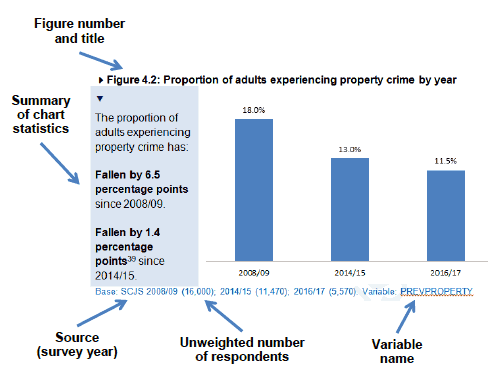
Table
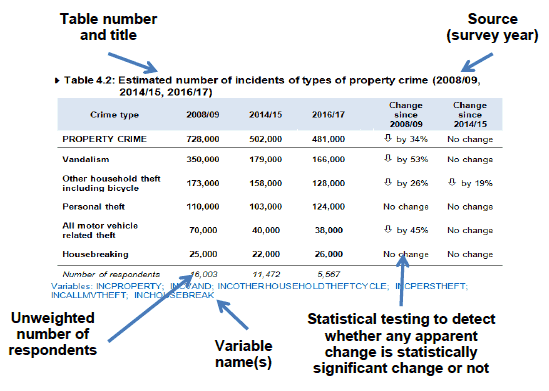
Unweighted Base
All SCJS percentages and rates presented in the figures and tables are based on weighted data (see Chapter 4 of the accompanying Technical Report for details on survey weighting). However, figures and tables show the unweighted base which represents the number of respondents / households in the specified group or the numbers of crimes that the analysis is based on [2] . In tables and figures these are rounded to the nearest multiple of 10 (unrounded numbers are provided in data tables released alongside this report).
Percentages & rounding
Most results presented in this report are rounded to whole numbers, but are available to three decimal places in the data tables released alongside this report. The prevalence estimates results presented in this report are provided to one decimal place which can sometimes be helpful where results are low. However, it should be noted that these results are estimates with assoicated ranges of uncertainty around them, which are taken account of in the statistical testing used in this report (and available more generally by using our Users Statistical Testing Tool).
Table row or column percentages may not sum to 100 due to rounding.
Percentages presented in tables and figures where they refer to the percentage of respondents, households or crimes that have the attribute being discussed may not sum to 100 per cent. Respondents have the option to refuse answering any question they did not wish to answer and the majority of questions have a 'don't know' option. Percentages for these response categories are generally not shown in tables and figures. In a small number of instances, to aid interpretation of the results, analysis is also presented based on data with 'don't know' and 'refused' responses removed.
A percentage may be quoted in the report text for a single category that is identifiable in the figures / tables only by summing two or more component percentages. In order to avoid rounding errors, the percentage has been recalculated for the single combined category and therefore may differ slightly ( i.e. by one or two percentage points) from the sum of the percentages derived from the figures/tables shown.
Also, percentages quoted in the report may represent variables that allow respondents to choose multiple responses. These percentages will not sum to 100 per cent with the other percentages presented. They represent the percentage of the variable population that selected a certain response category.
How reliable are SCJS results?
2016/17 was the first year that the survey interviews were administered by new contractors and interviewers. However, the approach to delivering the survey and analysing the results has remained consistent and the vast majority of the questionnaire is also very consistent to previous years. We also worked closely with the contractor to code survey crimes consistently with previous years to ensure that the results from the survey remain comparable with those from previous years.
There may be errors in the recall of participants as to when certain incidents took place, resulting in some crimes being wrongly included in, or excluded from, the reference period. A number of steps in the design of the questionnaire are taken to ensure, as far as possible, that this does not happen, for example repeating key date questions in more detail.
The SCJS gathers information from a sample rather than from the whole population and, although the sample is designed carefully, survey results are always estimates, not precise figures. If the experiences of those who cannot be contacted, or who refuse to take part, are different from those who are interviewed, and this cannot be corrected by weighting, then the survey will not reflect the experiences of the adults of Scotland as a whole. This means that the results are subject to a margin of error which can have an impact on how changes in the numbers should be interpreted, especially in the short-term.
To indicate the extent of uncertainty, this report presents a range of results with best estimates and also lower and upper estimates.The best estimate is the mean figure drawn from the sample. The lower and upper estimates are for the 95% confidence interval. The difference between these lower and upper estimates, the confidence intervals, are bands within which the 'true' value lies ( i.e. that value which would be obtained if a census of the entire population was undertaken). These confidence intervals are calculated to the 95% level, meaning that we would expect the survey data to lie within this range 95 times if the survey were to be repeated 100 times, each with a different randomly selected sample of adults. For example, when we examine incidence and prevalence of all crime, there is 95% certainty that the underlying incidence and prevalence figures lie between the lower and upper estimates.
Because of sampling variation, changes in reported estimates between survey years or between population subgroups may occur by chance. In other words, the change may simply be due to which respondents were randomly selected for interview. Whether this is likely to be the case has been assessed using standard statistical tests to examine whether differences are likely to be due to chance or represent a real difference. Only differences that are statistically significant at the 95% significance level are described as differences within this report.
In addition, it is often challenging to identify significant differences and changes for particularly rare events, for instance violent crime. For example, the prevalence of high frequency violent crime ( reported in Chapter 3) would have to have fallen to below around 0.15% in 2016/17 (from 0.3% in 2008/09) for it to have been identified as a significant change.
Where no statistically significant change has been found between two estimates, this has been described as showing 'no change'. The presentation of uncertainty and change in this report reflect best practice guidance produced by the Government Statistical Service ( GSS) [3] .
Uncertainty can be particularly high around some estimates, often where experiences are rare. We assessed this for crime incidence figures in this report by computing the relative standard error around the results ( RSE), which is equal to the standard error of a survey estimate divided by the survey estimate multiplied by 100. We have flagged results which have RSE values > 20% are due to the higher levels of uncertainty around the figures we recommend that such results are used with caution.
Where can I find more information and results?
This report contains a range demonstration tables with the body of each of the main report chapters. Many of these tables include breakdowns by respondent characteristics such as age, gender, deprivation, rural/urban and victim status. Further detail on many of these tables, for example with additional breakdowns, and full time series results, are provided in the data tables presented in Annex A.
We have also released a more comprehensive set of SCJS Data tables alongside this report which present further breakdowns of results, from a wide range of survey questions, by geographic, demographic, attitudinal or experiential characteristics of respondents.
The raw survey data files and survey documentation will be available soon after publication of this report from the UK Data Service.
How can I find out more about the SCJS?
Scottish Crime and Justice Survey - User Engagement
The SCJS is used in multiple ways and by multiple users across government, public services, academia and third sector. Engaging effectively with users is important in ensuring that the SCJS meets the needs of users.
If you want to find out more about work relating to the Scottish Crime and Justice Survey or any other facet of the work of the Scottish Government Statistics Group, you can through the following ways:
SCJS User Group
The SCJS team have established a user group to ensure that user engagement is an on-going part of each survey cycle. Members are drawn from government, academia, the justice system and third sector. The user group is an essential way to ensure that the survey remains relevant and able to respond to changing needs. If you would like to become involved in the user group, please contact us.
2018/19 Questionnaire Review
Our consultation inviting user feedback on the SCJS questionnaire for the 2018/19 survey has recently closed. The survey content has now been finalised with fieldwork commencing in early April 2017. More information on the review process, including the consultation paper and an outcomes report, can be found here.
ScotStat
Register with ScotStat a network for users and providers of Scottish Official statistics. It aims to improve communication amongst those interested in particular statistics and facilitate the setting up of working groups on specific statistical issues.
Contact
There is a problem
Thanks for your feedback